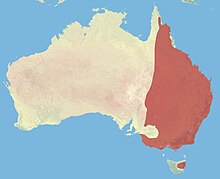Eastern grey kangaroo
| Eastern grey kangaroo Temporal range: 5–0 Ma Early Pliocene – Recent |
|
|---|---|
 |
|
| Scientific classification | |
| Kingdom: | Animalia |
| Phylum: | Chordata |
| Class: | Mammalia |
| Infraclass: | Marsupialia |
| Order: | Diprotodontia |
| Family: | Macropodidae |
| Genus: | Macropus |
| Species: | M. giganteus |
| Binomial name | |
|
Macropus giganteus (Shaw, 1790) |
|
 |
|
| Eastern grey kangaroo range | |
The eastern grey kangaroo (Macropus giganteus) is a marsupial found in southern and eastern Australia, with a population of several million. It is also known as the great grey kangaroo and the Forester kangaroo. Although a big eastern grey male typically masses around 66 kg (weight 145 lb.) and stands almost 2 m (6.6 ft.) tall, the scientific name, Macropus giganteus (gigantic large-foot), is misleading: the red kangaroo of the semi-arid inland is larger, weighing up to 90 kg.
The eastern grey kangaroo is the second largest and heaviest living marsupial and native land mammal in Australia. An adult male will commonly weigh around 50 to 66 kg (110 to 146 lb) whereas females commonly weigh around 17 to 40 kg (37 to 88 lb). Large males of this species are more heavily built and muscled than the lankier Red Kangaroo and can occasionally exceed normal dimensions. One of these, shot in eastern Tasmania weighed 82 kg (181 lb), with a 2.64 m (8.7 ft) total length from nose to tail (possibly along the curves). The largest known specimen, examined by Lydekker, had a weight of 91 kg (201 lb) and measured 2.92 m (9.6 ft) along the curves. When the skin of this specimen was measured it had a "flat" length of 2.49 m (8.2 ft). The eastern grey is easy to recognise: its soft grey coat is distinctive, and it is usually found in moister, more fertile areas than the red. Red kangaroos, though sometimes grey-blue in colour, have a totally different face than grey kangaroos. Red kangaroos have distinctive markings in black and white beside their muzzles and along the sides of their face. Grey kangaroos do not have these markings, and their eyes seem large and wide open. Where their ranges overlap, it is much more difficult to distinguish between eastern grey and western grey kangaroos, which are closely related. They have a very similar body and facial structure, and their noses/muzzles are fully covered with fine hair (though that is not obvious at a distance, their noses do look noticeably different from the noses of reds and wallaroos). The eastern grey's colouration is a light-coloured grey or brownish-grey, with a lighter silver or cream, sometimes nearly white, belly. The western grey is a dark dusty brown colour, with more contrast especially around the head.Indigenous Australian names include iyirrbir (Uw Oykangand and Uw Olkola) and kucha (Pakanh). The highest ever recorded speed of any kangaroo was 64 kilometres per hour (40 mph) set by a large female eastern grey kangaroo.
...
Wikipedia

